
Cranwell's horned frog, also called commonly the Chacoan horned frog, is a terrestrial frog in the family Ceratophryidae. The species is endemic to the dry Gran Chaco region of Argentina, Bolivia, Paraguay and Brazil. It, like other members of its genus, Ceratophrys, is commonly called the Pac-man frog, because of its resemblance to the video game character of the same name. Most adult specimens range from 8–13 cm (3.1–5.1 in) long and can weigh up to 0.5 kg (1.1 lb).
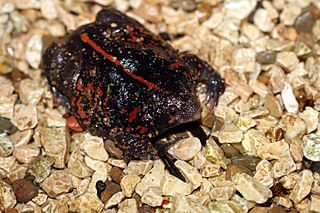
The Mexican burrowing toad is the single living representative of the family Rhinophrynidae. It is a unique species in its taxonomy and morphology, with special adaptations to assist them in digging burrows where they spend most of their time. These adaptations include a small pointed snout and face, keratinized structures and a lack of webbing on front limbs, and specialized tongue morphology to assist in feeding on ants and termites underground. The body is nearly equal in width and length. It is a dark brown to black color with a red-orange stripe on its back along with splotches of color on its body. The generic name Rhinophrynus means 'nose-toad', from rhino- (ῥῑνο-), the combining form of the Ancient Greek rhis and phrunē.
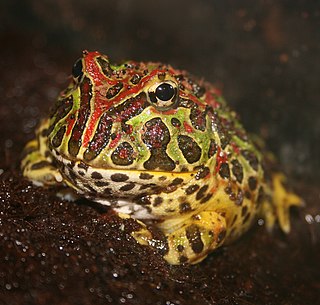
The Argentine horned frog, also known as the Argentine wide-mouthed frog, ornate horned frog, ornate horned toad, ornate pacman frog, or just the pacman frog is a species of frog in the family Ceratophryidae. The species is endemic to South America. It is the most common species of horned frog, in the grasslands of Argentina, Uruguay and Brazil. A voracious eater, it will attempt to swallow anything that moves close to its wide mouth, such as insects, rodents, lizards, and other frogs, even if this predator would suffocate in the process. It is also kept as an exotic pet. The nickname "pacman frog" is a reference to the popular 1980's arcade game Pac-Man, where Pac-Man himself eats quite a lot, and has a mouth that takes up most of its body, much like the Argentine horned frog.
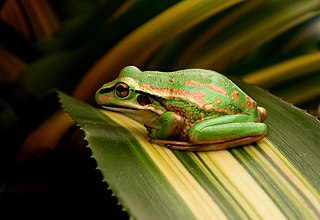
The green and golden bell frog, also named the green bell frog, green and golden swamp frog and green frog, is a species of ground-dwelling tree frog native to eastern Australia. Despite its classification and climbing abilities, it does not live in trees and spends almost all of its time close to ground level. It can reach up to 11 cm (4.5 in) in length, making it one of Australia's largest frogs.

Ceratophrys is a genus of frogs in the family Ceratophryidae. They are also known as South American horned frogs as well as Pacman frogs due to their characteristic round shape and large mouth, reminiscent of the video game character Pac-Man.
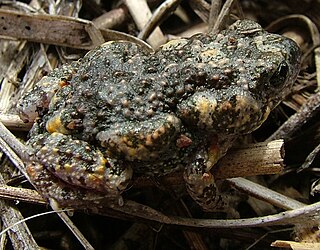
The wrinkled toadlet is a species of small, ground-dwelling frog in the family Myobatrachidae It is endemic to Australia. It is also commonly called the small-headed toadlet, red-groined toadlet or the chubby gungan.

The Panama cross-banded tree frog or pug-nosed tree frog is a species of frog in the family Hylidae found in the humid Pacific lowlands of southwestern Costa Rica to eastern Panama and in the Caribbean lowlands of Panama and northern Colombia. Males of the species utilize synchronous calling to hide their position from predators. Females create basins during amplexus and deposit fertilized eggs onto the surface of the water.
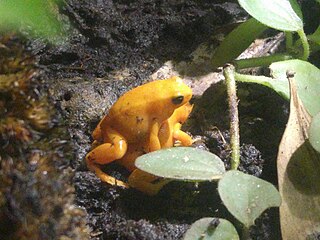
The dwarf Mexican tree frog is a species of frog in the family Hylidae endemic to Mexico.

Afrixalus fornasini is a species of frog in the family Hyperoliidae and is native to Africa. Its common name is Fornasini's spiny reed frog or the greater leaf-folding frog

The Brazilian horned frog is a species of frog in the family Ceratophryidae. It is endemic to Brazil. Its natural habitats are subtropical or tropical moist lowland forest, freshwater marshes, intermittent freshwater marshes, and ponds.

The Colombian horned frog or Venezuelan horned frog is a species of frog in the family Ceratophryidae. It is found in Colombia and Venezuela. Its natural habitats are dry savanna, subtropical or tropical dry shrubland, subtropical or tropical dry lowland grassland, and intermittent freshwater marshes.
The Caatinga horned frog is a species of frog in the family Ceratophryidae. It is endemic to Brazil. Its natural habitats are dry savanna, subtropical or tropical dry shrubland, subtropical or tropical dry lowland grassland, and intermittent freshwater marshes. They are voracious predators that use a sit-and-wait feeding strategy to ambush prey, which includes ants and small vertebrates. They are also known to be explosive breeders.
The Ecuadorian horned frog is a species of frog in the family Ceratophryidae. It is endemic to Ecuador. Its natural habitats are subtropical or tropical moist montane forest and intermittent freshwater marshes.
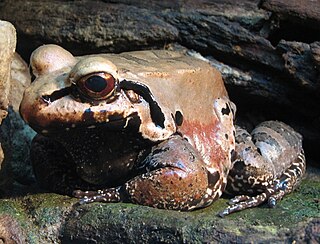
The smoky jungle frog is a species of frog in the family Leptodactylidae. It is found in Bolivia, Brazil, Colombia, Ecuador, Costa Rica, Panama, French Guiana, and Peru. Its natural habitats are tropical and subtropical moist broadleaf forests, subtropical or tropical swamps, subtropical or tropical moist montane forest, rivers, freshwater marshes, intermittent freshwater marshes, and aquaculture ponds.

The Palawan horned frog is a species of frog in the family Megophryidae. It is endemic to the Balabac and Palawan islands, in the Philippines. Its natural habitats are subtropical or tropical dry forests, subtropical or tropical moist lowland forests, subtropical or tropical moist montane forests, subtropical or tropical moist shrubland, rivers, and intermittent rivers. It is threatened by habitat loss.

The Mindanao horned frog is a species of amphibian in the family Megophryidae. It is endemic to the Philippines.

The Natal dwarf puddle frog is a species of frog in the family Phrynobatrachidae. It is found in Angola, Benin, Botswana, Burundi, Cameroon, Central African Republic, Republic of the Congo, Democratic Republic of the Congo, Ivory Coast, Eswatini, Eritrea, Ethiopia, Gambia, Ghana, Guinea, Guinea-Bissau, Kenya, Liberia, Malawi, Mali, Mozambique, Namibia, Nigeria, Rwanda, Senegal, Sierra Leone, South Africa, Sudan, Tanzania, Togo, Uganda, Zambia, Zimbabwe, and possibly Burkina Faso, Chad, Lesotho, and Mauritania.

The Angola river frog, or common river frog, is a species of frog in the family Pyxicephalidae. Formerly, it was placed in the family Ranidae.

Cornufer pelewensis, commonly known as Palau frog or Palau wrinkled ground frog, is a species of frog in the family Ceratobatrachidae. It is endemic to Palau.

The African bullfrog, also known as the Giant bullfrog or the South African burrowing frog, is a species of frog in the family Pyxicephalidae. It is also known as the pixie frog due to its scientific name. It is found in Angola, Botswana, Kenya, Malawi, Mozambique, Namibia, South Africa, Tanzania, Uganda, Zambia, Zimbabwe, and possibly the Democratic Republic of the Congo. It has been extirpated from Eswatini. It has long been confused with the edible bullfrog, and species boundaries between them, including exact range limits, are not fully understood. Additionally, P. angusticeps of coastal East Africa only was revalidated as a separate species in 2013.


















